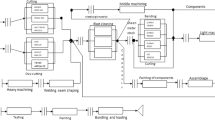Abstract
Multisite factories geographically distributed often have to implement an opportune tool to integrate their resources and demand forecasts in order to gather a specific production objective. The proposed research develops a distributed approach, for a network of independent enterprises, able to facilitate the capacity process by using a multiagent architecture and a cooperative protocol. The last one is based on game theory and, in particular, on Nash bargaining solution. Moreover, a discrete simulation environment has been developed to compare the proposed approach with the one in which no cooperation among enterprises exist. Several simulation scenarios were conducted to analyze the performances’ trends in various environment conditions. The goal has been the evaluation of the unallocated capacity, the unsatisfied demand, the profits generated by the network, the distribution of the transactions among the plants, and the number of activated links among plants. The simulation results show that the proposed approach leads to a better performance indexes and more relevant benefits when the dynamicity of the environment growths.
Similar content being viewed by others
References
Argoneto P, Bruccoleri M, Lo Nigro G, Perrone G, Noto La Diega S, Renna P (2006) High level planning of reconfigurable enterprises: a game theoretic approach. Ann CIRP 55(1):509–512
Baum J, Calabrese T, Silverman B (2000) Don’t go it alone: alliance network composition and startups’ performance in Canadian biotechnology. Strateg Manage J 21(3):267–294
Chen JC, Wang KJ, Wang SM, Jang SJ (2008) Price negotiation for capacity sharing in two-factory environment using genetic algorithm. Int J Prod Res 46(7):1847–1868
Christie RME, Wu SD (2002) Semiconductor capacity planning: stochastic modelling and computational studies. IIE Trans 34(2):131–144
Dollinger M (1985) Environmental contacts and financial performance of the small firm. J Small Bus Manage 23(1):24–30
Dowling M, Lechner C, Bau F (1998) Kooperative Wettbewerbsbeziehungen-eine empirische Untersuchung. In: Franke N, von Braun CF (eds) Innovationsforschung und Technologiemanagement. Springer, Berlin
Ip WH, Li Y, Man KF, Tang KS (2000) Multi-product planning and scheduling using genetic algorithm approach. Comput Ind Eng 38:283–296
Jiang AX (2000) Capacity trading among semiconductor manufacturing factories. Master’s thesis, Graduate Institute of Industrial Engineering, National Taiwan University
Lechner C, Dowling M (2003) Firm networks: external relationships as sources for the growth and competitiveness of entrepreneurial firms. Entrep Reg Dev 15:1–26
Renna P, Argoneto P (2008) Capacity allocation in multi-site factory environment: a multi agent systems approach. Proceedings of the Innovative and Cognitive Production Technology and Systems, 23–25 July, Naples, Italy
Tonshoff HK, Seilonen L, Teunis G, Leitao P (2000) A mediator-based approach for decentralised production planning, scheduling and monitoring. Report of the Espirit Program EP 24986
Wang KJ, Lin SH (2002) Capacity expansion and allocation for semiconductor testing facility with constrained budget. Prod Plan Control 13:429–437
Wu MC, Chang WJ (2007) A short-term capacity trading method for semiconductor fabs with partnership. Expert Syst Appl 33(2):476–483
Wu M-C, Hsiung Y, Hsu H-M (2005) A tool planning approach considering cycle time constraints and demand uncertainty. Int J Adv Manuf Technol 26(5):565–571
Wu SD, Erkoc M, Karabuk S (2005) Managing capacity in the high-tech industry: a review of literature. Eng Econ 50:125–158
Author information
Authors and Affiliations
Corresponding author
Rights and permissions
About this article
Cite this article
Renna, P., Argoneto, P. A game theoretic coordination for trading capacity in multisite factory environment. Int J Adv Manuf Technol 47, 1241–1252 (2010). https://doi.org/10.1007/s00170-009-2254-x
Received:
Accepted:
Published:
Issue Date:
DOI: https://doi.org/10.1007/s00170-009-2254-x




